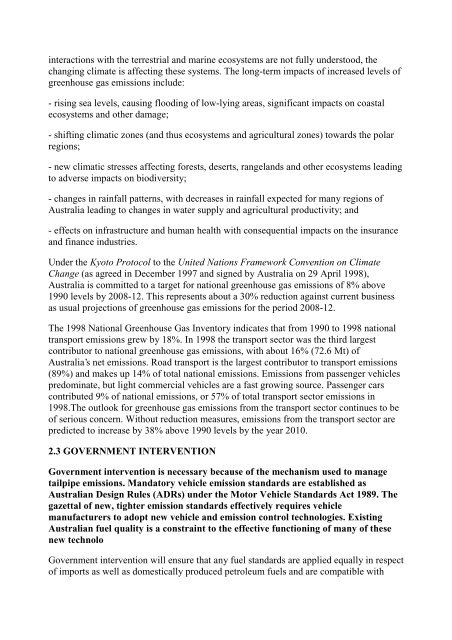National Fuel Quality Standards Regulation Impact Statement 1 ...
National Fuel Quality Standards Regulation Impact Statement 1 ...
National Fuel Quality Standards Regulation Impact Statement 1 ...
You also want an ePaper? Increase the reach of your titles
YUMPU automatically turns print PDFs into web optimized ePapers that Google loves.
interactions with the terrestrial and marine ecosystems are not fully understood, the<br />
changing climate is affecting these systems. The long-term impacts of increased levels of<br />
greenhouse gas emissions include:<br />
- rising sea levels, causing flooding of low-lying areas, significant impacts on coastal<br />
ecosystems and other damage;<br />
- shifting climatic zones (and thus ecosystems and agricultural zones) towards the polar<br />
regions;<br />
- new climatic stresses affecting forests, deserts, rangelands and other ecosystems leading<br />
to adverse impacts on biodiversity;<br />
- changes in rainfall patterns, with decreases in rainfall expected for many regions of<br />
Australia leading to changes in water supply and agricultural productivity; and<br />
- effects on infrastructure and human health with consequential impacts on the insurance<br />
and finance industries.<br />
Under the Kyoto Protocol to the United Nations Framework Convention on Climate<br />
Change (as agreed in December 1997 and signed by Australia on 29 April 1998),<br />
Australia is committed to a target for national greenhouse gas emissions of 8% above<br />
1990 levels by 2008-12. This represents about a 30% reduction against current business<br />
as usual projections of greenhouse gas emissions for the period 2008-12.<br />
The 1998 <strong>National</strong> Greenhouse Gas Inventory indicates that from 1990 to 1998 national<br />
transport emissions grew by 18%. In 1998 the transport sector was the third largest<br />
contributor to national greenhouse gas emissions, with about 16% (72.6 Mt) of<br />
Australia’s net emissions. Road transport is the largest contributor to transport emissions<br />
(89%) and makes up 14% of total national emissions. Emissions from passenger vehicles<br />
predominate, but light commercial vehicles are a fast growing source. Passenger cars<br />
contributed 9% of national emissions, or 57% of total transport sector emissions in<br />
1998.The outlook for greenhouse gas emissions from the transport sector continues to be<br />
of serious concern. Without reduction measures, emissions from the transport sector are<br />
predicted to increase by 38% above 1990 levels by the year 2010.<br />
2.3 GOVERNMENT INTERVENTION<br />
Government intervention is necessary because of the mechanism used to manage<br />
tailpipe emissions. Mandatory vehicle emission standards are established as<br />
Australian Design Rules (ADRs) under the Motor Vehicle <strong>Standards</strong> Act 1989. The<br />
gazettal of new, tighter emission standards effectively requires vehicle<br />
manufacturers to adopt new vehicle and emission control technologies. Existing<br />
Australian fuel quality is a constraint to the effective functioning of many of these<br />
new technolo<br />
Government intervention will ensure that any fuel standards are applied equally in respect<br />
of imports as well as domestically produced petroleum fuels and are compatible with
















